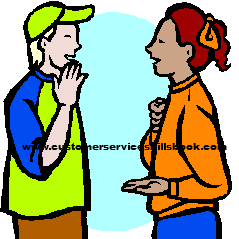Use Head Nodding Effectively With Customers to Avoid Misunderstandings
Nodding of the head is often used (and overused) by many people to signal agreement or to indicate that they are listening to a speaker during a conversation.
As a customer service representative, you must be careful to occasionally pause to ask a question for clarification when you are using this nonverbal communication technique or when you are watching others who are doing so. Stop and ask for, or provide, feedback through a paraphrased message. A question such as, “So what do you think of what I just said?” will quickly tell you whether the other person is listening and understands your meaning or is simply being polite by smiling and nodding—but not understanding. The latter sometimes happens when there are gender or cultural differences or when someone speaks a native language other than yours.
If you are a woman, be careful not to overuse the nodding technique. Some research has shown that many North American women often nod and smile more than men during a conversation. Doing so excessively might damage your credibility or effectiveness, especially when you are speaking to a man. The interpretation may be that you agree or that you have no opinion, whether you do or not.
Although nodding your head generally signals agreement, if you nod without a verbal acknowledgment or paralanguage (a vocal effect such as “uh-huh, I see, hmmm”), a missed or misinterpreted cue could result. For example, suppose that you want to signal to a customer that you are listening to and understand her request. You may nod slowly, vocalize an occasional “I see” or “Uh-huh,” and smile as she speaks. She might interpret this to mean that you are following her meaning and are nonverbally signaling acceptance of it. This can present challenges if she is stating something contrary to your organization’s policy or that is outside your level of authority. In such an instance, she might misinterpret your non-verbal signals by thinking that you agree with her, not that you are merely signaling to understand. Later, she might be upset, saying something like, “Well, earlier you nodded agreement when I said I wanted a replacement.”
To learn more about effective non-verbal communication when interacting with customers or potential customers in order to deliver excellent customer service, get copies of Please Every Customer: Delivering Stellar Customer Service Across Cultures and Customer Service Skills for Success.

